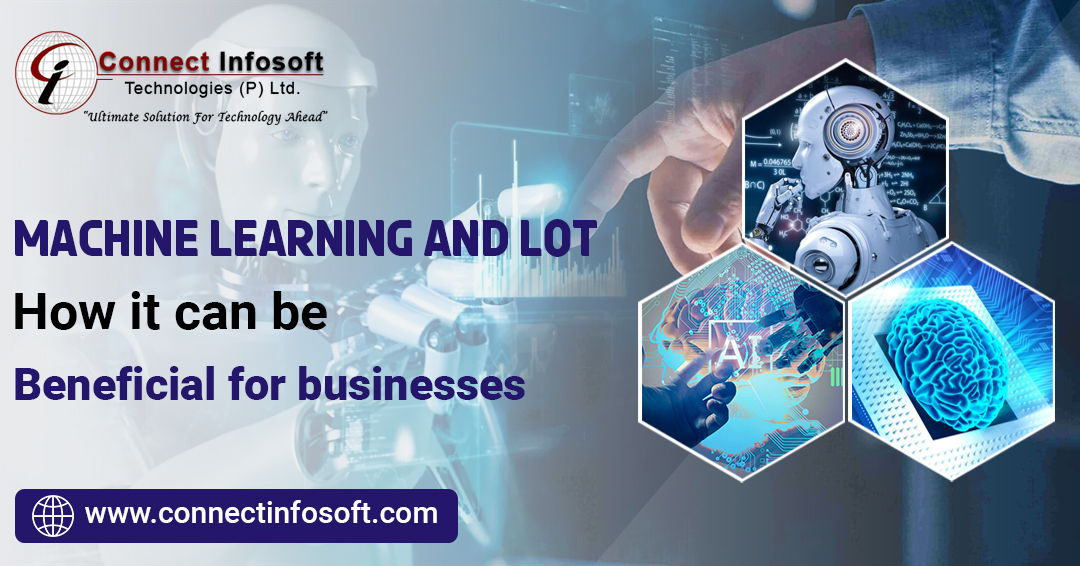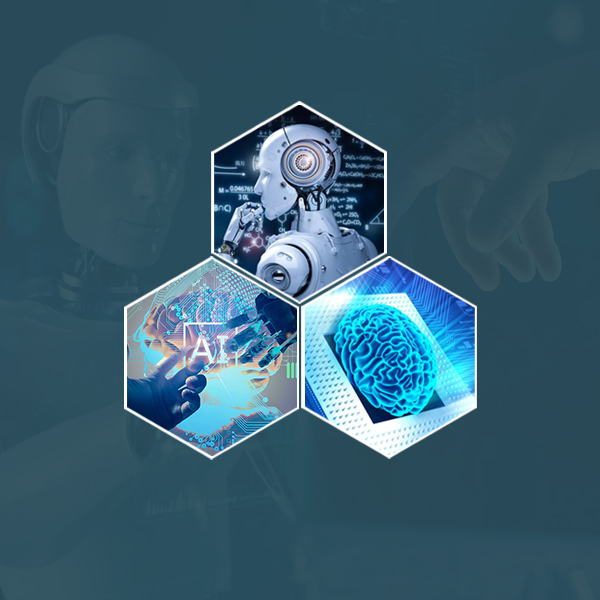Machine Learning And IoT: How It Can Be Beneficial For Businesses?

The machine learning field is growing rapidly, along with IoT. Small cameras and other IoT components are now easily available on mobile devices, computers, traffic control systems, parking systems, and home appliances. Millions of IoT devices are manufactured worldwide that collect a variety of data kept in the machines through the internet, allowing machines to understand more precisely that data and make them more useful in a simple way.
Machine learning and the Internet of Things (IoT) are two powerful technologies that, when combined, can bring significant benefits to businesses.
Here are some ways in which the integration of machine learning and IoT can be advantageous:
- Predictive Maintenance: IoT devices can collect real-time data from various sensors embedded in equipment or machinery. Machine learning algorithms can analyze this data to detect patterns and anomalies, allowing businesses to predict when maintenance is required. By addressing maintenance needs proactively, companies can reduce downtime, avoid costly repairs, and improve overall operational efficiency.
- Optimized Resource Management: Machine learning algorithms can analyze data collected from IoT devices to optimize resource allocation and consumption. For example, in smart buildings, sensors can monitor energy usage patterns, and machine learning algorithms can identify opportunities to reduce energy waste or optimize HVAC systems for better efficiency. This results in cost savings and reduced environmental impact.
- Enhanced Customer Experience: IoT devices can capture data about customer behavior and preferences. By applying machine learning techniques to this data, businesses can gain insights into customer preferences, personalize their offerings, and provide a more tailored and satisfying customer experience. For instance, machine learning algorithms can analyze data from wearables to understand individual health patterns and deliver personalized wellness recommendations.
- Supply Chain Optimization: The integration of IoT devices with machine learning can enable businesses to optimize their supply chain operations. Real-time data from IoT sensors placed on inventory, vehicles, or production lines can be analyzed by machine learning algorithms to identify bottlenecks, predict demand, and optimize inventory levels. This leads to improved inventory management, reduced costs, and more efficient logistics.
- Enhanced Security and Risk Management: IoT devices generate vast amounts of data, and machine learning algorithms can help identify patterns and anomalies that indicate security threats or risks. By continuously monitoring and analyzing IoT data, businesses can detect and respond to cybersecurity breaches, equipment failures, or other risks in real-time, minimizing the potential damage.
- Product Innovation: IoT devices generate rich data about product usage, performance, and customer behavior. By leveraging machine learning algorithms, businesses can gain insights from this data to drive product innovation and improvement. The combination of IoT and machine learning can enable companies to identify new market opportunities, understand customer needs, and develop data-driven strategies for product development and enhancement.
Market Size of Machine Learning and IoT
The market size of machine learning and IoT is dynamic and continually evolving. While I don't have access to real-time market data, I can provide you with information based on the knowledge available up until my September 2021 cutoff. Please note that the market size may have changed since then.
Machine Learning Market Size:
The global machine learning market has been experiencing significant growth in recent years. According to a report by Grand View Research, the global machine learning market size was valued at USD 8.43 billion in 2020 and is projected to reach USD 117.19 billion by 2027, growing at a CAGR of 39.2% during the forecast period. The increasing adoption of machine learning across various industries, such as healthcare, finance, retail, and manufacturing, is driving this growth.
LoT Market Size:
The Internet of Things (IoT) market has also been expanding rapidly. According to a report by Market Research Future, the global IoT market size was valued at USD 190 billion in 2020 and is expected to reach USD 1,386 billion by 2026, growing at a CAGR of 25.68% during the forecast period. The proliferation of connected devices, advancements in wireless communication technologies, and the increasing adoption of IoT solutions across industries like manufacturing, healthcare, transportation, and smart cities contribute to the growth of the IoT market.
Combined Impact:
The convergence of machine learning and IoT is driving further growth and opportunities. As more IoT devices generate massive amounts of data, machine learning algorithms play a crucial role in extracting meaningful insights and making predictions. The integration of machine learning with IoT enables businesses to unlock the full potential of their data, leading to improved operational efficiency, cost savings, and enhanced decision-making.
The combined market size of machine learning and IoT is challenging to quantify precisely as both technologies have synergistic effects and are often integrated into various industry-specific applications. However, it is evident that both markets are experiencing significant growth and offer substantial opportunities for businesses across sectors.
Benefits of Machine Learning and IoT
The integration of Machine Learning (ML) and the Internet of Things (IoT) offers several benefits for businesses:
Real-time Decision Making
ML algorithms can process the vast amount of data collected by IoT devices in real-time, enabling businesses to make faster and more accurate decisions. This real-time analysis can be used to optimize operations, detect anomalies, or trigger automated actions based on predefined rules.
Predictive Analytics
By applying ML techniques to IoT data, businesses can gain insights and make predictions about future outcomes. ML models can analyze historical IoT data and identify patterns, trends, and correlations that can help in forecasting demand, predicting maintenance needs, or anticipating customer behavior.
Cost Reduction and Efficiency
The combination of ML and IoT can lead to cost savings and increased operational efficiency. ML algorithms can optimize resource allocation, energy consumption, and supply chain management based on real-time IoT data. This can result in reduced energy waste, improved inventory management, optimized production processes, and minimized downtime.
Enhanced Customer Experience
IoT devices capture a wealth of customer-related data, and ML algorithms can leverage this data to deliver personalized and targeted experiences. By analyzing IoT data, businesses can understand customer preferences, behavior patterns, and buying habits. This enables them to offer personalized recommendations, tailored marketing campaigns, and improved customer support.
Improved Product Quality and Innovation
ML algorithms can analyze data from IoT sensors embedded in products to identify patterns or anomalies that indicate product defects or performance issues. This helps businesses improve product quality, identify areas for innovation, and proactively address customer concerns. ML can also be used to analyze user feedback and sentiment analysis to gather insights for product improvement.
Enhanced Security and Risk Management
IoT devices can be vulnerable to security threats, and ML algorithms can help detect and respond to such threats in real-time. ML models can analyze IoT data to identify abnormal behavior, detect potential cyber-attacks, or trigger alerts for unauthorized access. This strengthens the security of IoT systems and protects critical business assets.
Data-driven Insights and Decision-making
ML algorithms can uncover hidden patterns and insights from the vast amount of data collected by IoT devices. By leveraging ML techniques, businesses can make data-driven decisions, identify optimization opportunities, and gain a deeper understanding of their operations, customers, and markets.
Machine learning and IoT in Healthcare
Machine learning and the Internet of Things (IoT) have tremendous potential to transform the healthcare industry. Here are some ways in which the integration of machine learning and IoT can be beneficial in healthcare:
Remote Patient Monitoring
IoT devices, such as wearable sensors or implantable devices, can continuously collect patient health data, including vital signs, activity levels, sleep patterns, and more. Machine learning algorithms can analyze this data to detect anomalies, predict deteriorating health conditions, or identify patterns that may indicate the onset of diseases. This enables healthcare providers to remotely monitor patients, intervene early, and provide personalized care.
Personalized Treatment and Precision Medicine
Machine learning algorithms can analyze large volumes of patient data, including electronic health records, genomic information, and lifestyle data collected by IoT devices. By applying machine learning techniques, healthcare professionals can gain insights into individual patient profiles, identify disease risks, and develop personalized treatment plans. Machine learning can also aid in the discovery of new drug targets and the development of precision medicine approaches tailored to specific patient populations.
Medication Management
IoT-enabled devices, such as smart pill bottles or wearable drug delivery systems, can help patients manage their medications more effectively. Machine learning algorithms can analyze patient adherence patterns, predict medication adherence issues, and provide reminders or interventions to ensure proper medication usage. This can help improve patient outcomes, reduce medication errors, and enhance medication adherence rates.


